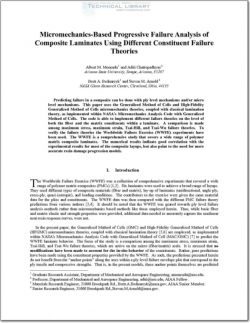NASA-ASU

- Version
- 215 Downloads
- 549.54 KB File Size
- 1 File Count
- June 15, 2016 Create Date
- June 15, 2016 Last Updated
Micromechanics-Based Progressive Failure Analysis of Composite Laminates Using Different Constituent Failure Theories

Predicting failure in a composite can be done with ply level mechanisms and/or micro
level mechanisms. This paper uses the Generalized Method of Cells and High-Fidelity
Generalized Method of Cells micromechanics theories, coupled with classical lamination
theory, as implemented within NASA's Micromechanics Analysis Code with Generalized
Method of Cells. The code is able to implement different failure theories on the level of
both the fiber and the matrix constituents within a laminate. A comparison is made
among maximum stress, maximum strain, Tsai-Hill, and Tsai—Wu failure theories. To
verify the failure theories the Worldwide Failure Exercise (WWFE) experiments have
been used. The WWFE is a comprehensive study that covers a wide range of polymer
matrix composite laminates. The numerical results indicate good correlation with the
experimental results for most of the composite layups, but also point to the need for more
accurate resin damage progression models.
I. Introduction
he Worldwide Failure Exercise (WWF E) was a collection of comprehensive experiments that covered a wide
range of polymer matrix composites (PMCs) [1,2]. Six laminates were used to achieve a broad range of layups.
They used different types of composite materials (fiber and matrix), lay-up of laminates (unidirectional, angle-ply,
cross-ply, quasi-isotropic), and loading conditions. The contributors to the exercise were given the same material
data for the plies and constituents. The WWFE data was then compared with the different PMC failure theory
predictions from various authors [3,4]. It should be noted that the WWFE was geared towards ply level failure
analysis methods rather than micromechanics based methods like those employed herein. Thus, while basic fiber
and matrix elastic and strength properties were provided, additional data needed to accurately capture the nonlinear
neat resin response curves, were not.
In the present paper, the Generalized Method of Cells (GMC) and High-Fidelity Generalized Method of Cells
(HF GMC) micromechanics theories, coupled with classical lamination theory [5,6] are employed, as implemented
within NASA's Micromechanics Analysis Code with Generalized Method of Cell (MAC/GMC) [7] to predict the
WWFE laminate behavior. The focus of the study is a comparison among the maximum stress, maximum strain,
Tsai-Hill, and Tsai-Wu failure theories, which are active on the micro (fiber/matrix) scale. It is stressed that no
modifications have been made to account for the in-situ behavior of the constituents. Rather, pure predictions
have been made using the constituent properties provided by the WWF E. As such, the predictions presented herein
do not benefit from the “anchor points” along the axes within a ply level failure envelope plot that correspond to the
ply tensile and compressive strengths. That is, in the present models, these anchor points themselves are predicted
| File | Action |
|---|---|
| NASA-ASU Micromechanics-Based Progressive Failure Analysis of Composite Laminates Using Different Constituent Failure Theories.pdf | Download |

Comment On This Post